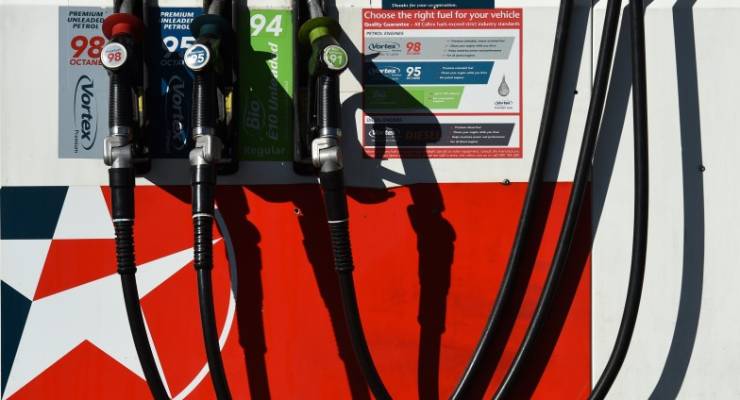
Rarely do we stop to consider how uniquely dirty our national fuel of choice, unleaded petrol, is. But Australia’s obsession with it needs addressing and government inaction is leaving the country sitting in the dust in a race for cleaner fuel.
Australia is ranked lowest of the 35 OECD member countries in quality. We’ve fallen to 70th in last year’s top 100 world ranking of petrol quality, which is based on regulated sulfur content. Plans proposed in 2016 to completely kill off regular unleaded petrol look set to be sidelined after the Department of Environment quietly slipped its Better Fuels for Cleaner Air 2018 discussion paper in at the start of this year.
Australia’s regulated sulfur limit for regular unleaded petrol is 150 parts per million (ppm) and 50ppm for premium unleaded. That’s compared to the European Union, where regulated sulfur content is 10ppm. The report proposes three options that would either scrap regular unleaded or bring the sulfur content down to 50ppm and 10ppm in premium unleaded.
This would bring standards in Australia in line with European Union standards, which countries are increasingly turning to. Even the Australian Institute of Petroleum (AIP) recognises that a lower sulfur future is not in question.
Paul Barrett, CEO of the AIP told Crikey it was ‘“untenable for Australia to be out of step” as China and the US move to 10ppm.
Why this matters
Cleaner fuel means cleaner air and cleaner air means better health. Higher sulfur levels lead to higher oxides of nitrogen emissions, which contributes to worse health in our cities.
But cleaner fuel also has a cost: upgrading refineries to extract more sulfur means filling up at the bowser will leave your pocket feeling lighter. Sandra Kentish, head of the School of Chemical and Biomedical Engineering at The University of Melbourne, told Crikey that sulfur in fuel not only worsens air quality but actually clogs up cars’ emissions control technologies.
But the AIP said anything which requires investment could make refining in Australia unprofitable and cause Australia’s four remaining refineries to close.
So what’s the plan?
Three options — B, C and F — are proposed in the Better Fuels for Cleaner Air report.
Option B is the strongest measure, and would bring Australian fuel standards into line with Europe. It would include phasing out regular unleaded petrol entirely. The Federal Chamber for Automotive Industries (FCAI) supports this option, and it fits most closely with plans proposed in 2016.
Option C would harmonise with European standards as per Option B, with the exception that regular unleaded petrol is retained with the lower sulfur level of 10 ppm. Option C is recommended by the report’s authors as the best option.
Option F was proposed by the AIP, who claim that the two other options could see the Australian refining industry go under. Under this option sulfur would be reduced to 10 ppm but would only take place by 2027. A key point of the Department of Environment’s modelling on Option C concluded there to be big health benefits from actually keeping the dirtier petrol, as our doddering fleet of cars designed for regular unleaded would emit more nasty gasses if forced to use premium.
Independent consultants at Marsden Jacob Associates, in a cost-benefit analysis on these options, found that option C came back with the strongest positive return, followed by Option F, while Option B was negative. Australia’s four aging refineries produce fuel that’s a lower sulfur content than our limit, but trying to clean up their act would require major upgrades.
Paul Barrett says it will cost something in the order of $1 billion or more. “The benefit of moving forward to 10 ppm is only minor compared to the large expense the refiners will have to undertake,” he told Crikey.
Australia’s dirty fuel a roadblock to some Euro 6 cars
But Peter Brewer of the FCAI told Crikey that not only was Australia lagging behind, but keeping a foot on the brake for sulfur standards meant Aussies aren’t able to access cars designed for higher quality fuel. As a result, and compounding the problem, Australia is being supplied with cheap, new cars designed for high sulfur fuel, to go with the older models that are stuck using it.
Brewer said the unavailability of cars would become an accelerated process as Europe moves ahead with its program of high quality, low sulfur fuel as the market’s base transport fuel.
Feedback is currently being taken on this latest round. The AIP is lobbying hard for option F, while many others are pushing the government to go the whole hog and make the jump to option B — the end of dirty unleaded fuel in Australian cars. Whether that’s simply pipe dream is yet to be seen.
Correction: This article originally stated that “sulfur in fuel forms sulphur dioxide”. This has been corrected to “higher sulfur levels lead to higher oxides of nitrogen emissions”. The findings of Marsden Jacob Associates’ cost-benefit analysis have also been clarified.








Curiously neglected, the conversion of our fossil-fed refineries to recycled CO2 would supply zero-sulfur fuel to our remaining internal combustion engines. Although they will still emit GHG, the recycled CO2 meets the “net zero emissions” by 2100 requirement of the Paris Agreement.
The clock is ticking. Replacing all fossil feedstock is not an option, it is a necessity.
The article doesn’t explain how the cost of supposed major upgrades could “cause Australia’s four remaining refineries to close”. Is there a non-refinery alternative that they would lose out to? Australians love their cars, and hardly any of them are electric at the moment. They’re going to keep buying petrol even if it becomes more expensive (as it does, from time to time.)
An interesting piece, but should it not be ‘sulphur’?
“Sulfur” has long been the common usage in chemistry, more recently made official by the International Union of Pure and Applied Chemistry (IUPAC).
Meanwhile, as we waddle towards the bottom of the national obesity pile, there are vast acreages of sugar cane in marginal areas demanding yet more government subsidies for their pure, white & deadly product.
Buy the entire crop, on 20 year contracts, and turn it into ethanol.
Those with shares in dentistry & diet scams can try growing boutique-style – “each individual cane can lovingly cut whilst singing hymns to the plant gods” or go back to extracting the sweet stuff from swedes & turnips as they did, pre slave trade to the Windies.
Tetraethyl lead is one of the greatest chemicals of all time. In extremely small quantities it could raise fuel raitings up to 100 octane and as far as 150 octane. Too bad it was also one of the deadliest chemicals ever produced.
Modern octane boosters are more expensive, but are we being gouged by oil company’s when buying 95 and 98 fuel is a topic that the ACCC is too gutless to challenge. What’s making the situation even worse is the bullshit claims about the octane ratings boost and improved enviromental outcomes from ethanol additives in fuel. And the fact that ethanol producers are major sponsors for all sides of government, just throws a match on any reasonable scientific debate.